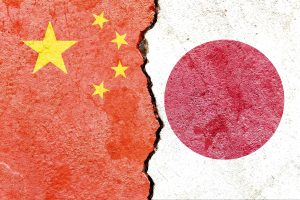Japan today confronts a maritime challenge similar to the Philippines’ ongoing flare-up with China over the latter’s deployment of a floating barrier near disputed territory in the South China Sea.
Since 2013, the China Coast Guard has violated Japan’s territorial waters around the Senkaku Islands (known as the Diaoyu Islands in China) on a nearly daily basis. Moreover, China’s People’s Liberation Army Navy oceanographic survey and intelligence collection ships occasionally transit Japanese-claimed territorial waters. Japan perceives these actions as a unilateral effort by China to change the maritime status quo and test Japan’s territorial claims.
The latest development is China’s deployment of an oceanographic/weather buoy inside the Japanese EEZ.
On September 18, 2023, the government of Japan confirmed China’s deployment of a buoy inside the Japanese exclusive economic zone (EEZ) near the Senkaku Islands. Japan Coast Guard first spotted the yellow research buoy 43 nautical miles northwest of the Senkaku’s Uotsuri Island on July 11, 2023. This position placed the buoy over a one-quarter nautical mile into the Japanese side of the median line separating the EEZs of Japan and China in the East China Sea (Japan considers the median line to be the maritime boundary between the two, while China does not). China previously deployed similar buoys near this location in both 2013 and 2018.
China’s currently-deployed oceanographic/weather buoy is approximately 10 meters in diameter and bears the label “中国海洋观测浮标QF212” (China Ocean Survey Buoy QF212). QF likely stands for 气象浮标 (qixiang fubiao, meaning weather buoy), and the numeral 2XX designates it as an East China Sea buoy. (1XX and 3XX are the Chinese designations for Yellow Sea buoys and South China Sea buoys, respectively.)
Government of Japan and Japanese press analyses indicate China likely deployed the QF212 buoy on or about July 2, when Chinese large buoy working and research ship Xiang Yang Hong 22 operated near QF212’s location, according to commercial satellite imagery and Automatic Identification System (AIS) data.
Japan believes QF212’s deployment violates the United Nations Convention on the Law of Sea (UNCLOS). Under UNCLOS, coastal states like Japan must consent before foreign vessels may conduct marine scientific research inside their EEZ or on their surrounding continental shelves. To date, China has not sought – nor has Japan given – consent for China to conduct such maritime research inside Japan’s claimed EEZ. Japanese consent is also required before any structures may be installed inside its EEZ, per UNCLOS.
China has done little to quell Japan’s concerns about the buoy, but in other incidents China has attempted to reassure Tokyo that its actions across the East China Sea median line were not intended to violate UNCLOS.
On September 21, for example, the China Maritime Administration (CMA) retracted its announcement that a mobile drilling ship would operate in the East China Sea after a typographic error in the ship’s voyage plan indicated the vessel planned to drill inside the Japanese EEZ. China also communicated the CMA’s error directly to the government of Japan via diplomatic channels.
China’s lack of clarification in the case of the QF212 buoy likely indicates that QF212’s deployment in Japan’s EEZ is intentional, possibly an attempt to press China’s claim that its own EEZ stretches past the median line to the end of the extended continental shelf.
In response to QF212, Chief Cabinet Secretary Matsuno Hirokazu stated that Japan had launched a diplomatic protest and demanded the buoy’s immediate removal.
Some Japanese politicians suggested the possibility of further action. They alluded that Japan should follow the lead of the Philippines at Scarborough Shoal by forcibly removing the buoy from Japan’s EEZ. The government of Japan has not undertaken such action, likely due to Japan’s objections to China’s own belligerent tactics in enforcing its excessive maritime claims.
Regardless of Japan’s response, QF212’s deployment marks the latest in a series of maritime challenges China levies against Japan. While the buoy probably only collects weather and oceanographic research data, Tokai University Ocean Policy Professor Yamada Yoshiko believes the deployment aims to “not just collect data, but to show China’s presence around the Senkaku Islands and [ability] to control the Senkaku Islands.”

































